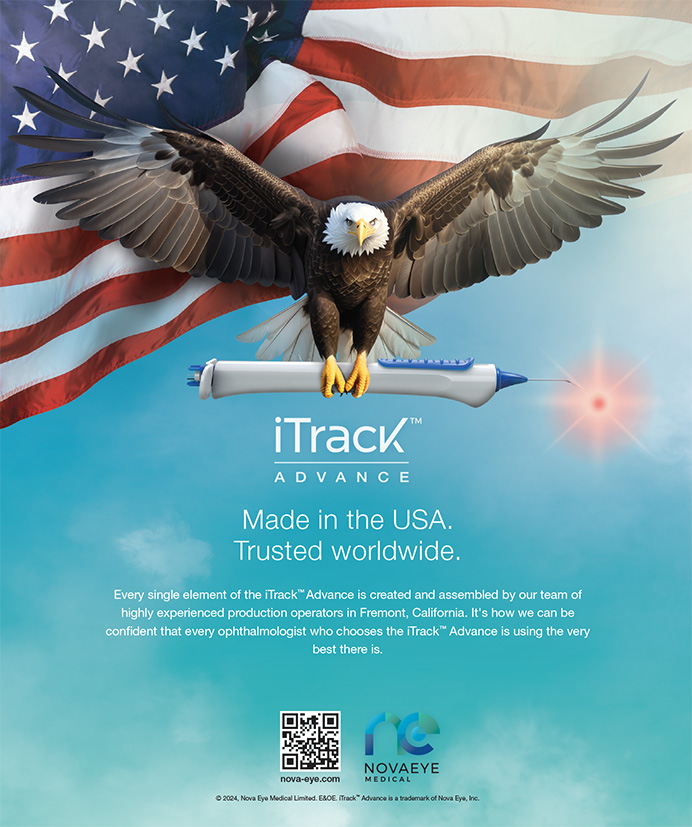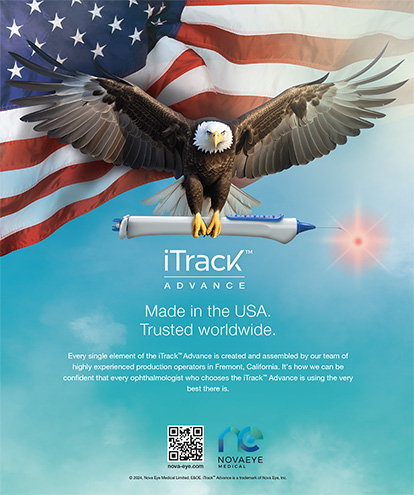Dr. Vasavada regularly performs stromal hydration, at both the clear corneal temporal incision and paracentesis, as part of his strategy for sealing the wound after cataract surgery. Further, he has found stromal hydration to be a useful adjunct in clear corneal cataract surgery, because it allows the adequate approximation of the anterior and posterior aspects of the corneal tunnel.
Today, surgeons perform stromal hydration to enhance the sealing of the wound and thus preclude the need for sutures. The stromal hydration of the incisions was advocated and popularized by Fine.1 In a recent study, he and his colleagues used anterior segment optical coherence tomography to evaluate the profiles of the clear corneal incision's construction and architecture. They found persistent stromal swelling from stromal hydration, even on the first postoperative day.2 Furthermore, Wong found that stromal hydration assists in securing clear corneal incisions, thereby helping to prevent endophthalmitis.3
Some critics of clear corneal incisions maintain that stromal hydration is detrimental to structural integrity. This assertion presumes that the endothelial pump has no effect on stromal hydration.
We decided to investigate whether hydrating the corneal stromal incision has any impact on the ingress of fluid from the ocular surface into the anterior chamber. This article summarizes our findings.
METHODOLOGY
We prospectively randomized 80 consecutive patients undergoing phacoemulsification to an evaluation of the self-sealing property of the corneal incision in response to stromal hydration. For this trial, we used 0.0125 trypan blue solution as a tracer for quantifying the ingress of fluid from the ocular surface into the anterior chamber, and we measured the optical density of the dye in the fluid aspirated from the anterior chamber. We performed microcoaxial phacoemulsification by creating two clear corneal paracentesis incisions of 1 mm and a single-plane temporal clear corneal tunnel of 2.2 mm with an internal entry of at least 1.5 mm. We measured the internal entry with specially designed calipers. If it were less than 1.5 mm, we excluded the eye from the study. We used standardized surgical techniques with the Infiniti Vision System (Alcon Laboratories, Forth Worth, TX). Immediately after completing the cataract procedure, we randomly assigned the eyes to group 1 or 2. For group 1, we gently irrigated the main incision, including the stroma of the sidewalls, with BSS Plus (Alcon Laboratories, Inc.) to facilitate the apposition of the roof and floor of the incision. We continued injecting BSS Plus at the internal ends of the lateral walls to seal the internal entry completely. In both the groups, we removed the speculum from the eye to facilitate the application of trypan blue (0.0125, pH = 7.39, osmotic pressure = 1.22; Shah & Shah, Calcutta, India) over the conjunctival surface with a micropipette. Patients were advised to blink voluntarily.
After 2 minutes, we gently irrigated the eyes with BSS Plus to wash the excess trypan blue from the ocular surface. Subsequently, we collected 0.1 mL of anterior chamber aspirate by means of a 27-gauge needle mounted on a tuberculin syringe and calculated the amount of dye present (Figure 1). At the end of the trial, in both groups, we sealed the paracentesis incisions along with the main incision by hydrating the stroma with BSS Plus (Figure 2).
We estimated the amount of trypan blue in the aspirate from the anterior chamber by measuring the optical density with a UV-Visible spectrophotometer (Lambda 25; PerkinElmer, Inc., Waltham, MA). We created a standard curve at 595 nm where the maximum absorbance was found when undiluted trypan blue solution was scanned from 190 to 1,100 nm. Simultaneously, using normal saline, we created another standard curve from serial dilutions of undiluted trypan blue (0.012) down to diluted trypan blue (1:100,000), and we measured absorbance levels at 595 nm. The samples of aspirated aqueous containing trypan blue were measured for optical density by adding 0.9 mL of normal saline to the cuvette. The optical-density values were converted into dilution factors using the standard graph mentioned earlier. The quantitative difference in the ingress between the two groups was determined by comparing the dilution factors. The dilution factor of trypan blue was converted into log values, because the values were increasing and to simplify our calculations. The results were expressed as mean and median values.
OBSERVATIONS
We studied the ingress of trypan blue into the anterior chamber in both groups (Table 1). We found that it was several times lower in the eyes of group 1 (stromal hydration) versus group 2 (not hydrated). The mean log value was significantly higher for group 1, a finding indicating less penetration of trypan blue into the anterior chamber compared with that for group 2 (3.12 ±0.48 vs 2.14 ±0.60, P<.001). Similarly, there was a statistically significant difference in the mean dilution of trypan blue in the aqueous aspirate. The higher the dilution, the lower the penetration of trypan blue into the anterior chamber (1:11,337 ±30,341.46 [group 1] vs 1:220 ±154.15 [group 2], P<.001).
CONCLUSION
Our clinical trial is the first of its kind to demonstrate the impact of hydrating corneal incisions on the ingress of extraocular fluid into the anterior chamber during microcoaxial phacoemulsification.4 We believe that hydrating these incisions may help to prevent aqueous leakage and also, to some extent, the inflow of fluid from the ocular surface into the anterior chamber, because it restricts the ingress of small particles. In our experience, a corneal incision coupled with stromal hydration is consistently self-sealing and resistant to collapse. In some situations, when Dr. Vasavada notices any distortion or stretching of the incision or even a short internal entry (which raises questions about the integrity of the incision), he does not hesitate to place a single 10?0 Vicryl suture (Ethicon Inc., Somerville, NJ). The situations in which he has found stromal hydration most helpful are cases involving large incisions during standard coaxial phacoemulsification.
Our clinical findings provide evidence in favor of the hydration of corneal incisions after phacoemulsification. The benefits of stromal hydration are far from imaginary.
Devarshi U. Gajjar, PhD, is a postdoctoral fellow at Iladevi Cataract & IOL Research Centre, Raghudeep Eye Clinic, Memnagar, Ahmedabad, India. She acknowledged no financial interest in the products or companies mentioned herein.
Deepak Pandita, MS, is a research fellow at Iladevi Cataract & IOL Research Centre, Raghudeep Eye Clinic, Memnagar, Ahmedabad, India. He acknowledged no financial interest in the products or companies mentioned herein.
Mamidipudi. R. Praveen, DOMS, is a junior consultant at Iladevi Cataract & IOL Research Centre, Raghudeep Eye Clinic, Memnagar, Ahmedabad, India. He acknowledged no financial interest in the products or companies mentioned herein.
Abhay R. Vasavada, MS, FRCS, is Director of the Iladevi Cataract & IOL Research Centre, Raghudeep Eye Clinic, Memnagar, Ahmedabad, India. He acknowledged no financial interest in the products or companies mentioned herein. Dr. Vasavada may be reached at 91 79 27492303 or 91 79 27490909; icirc@abhayvasavada.com.


